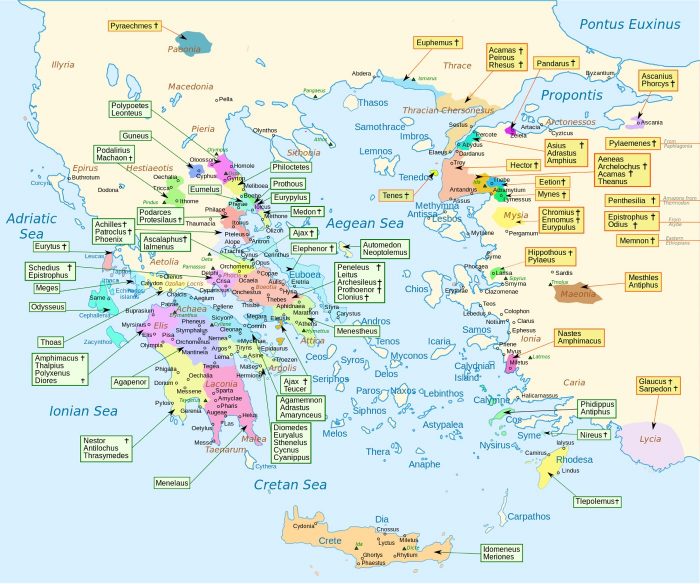
Click here to see a larger version of the map.
You’ve adjusted to the strangeness of names like Ascalaphus and Phidippus. You’ve more or less figured out who’s on which side in the ancient war between Greece and Troy. But as literary epics will do—from the ancient Greeks and Indians to the 19th century Russians—Homer’s Iliad also presents you with several logistical puzzles you must either ignore or spend countless hours trying to solve: you are given the names of major and minor characters’ hometowns, ranging all over the Adriatic, Ionian, Cretan, and Aegean Seas. Doubtless you have no idea where most of these places were.
Again and again, place names occur in rapid succession, and you’re told not only who hails from where, but who commands and conquers which city. Just a smattering of examples from Book II (in Samuel Butler’s translation):
Ulysses led the brave Cephallenians, who held Ithaca, Neritum with its forests, Crocylea, rugged Aegilips, Samos and Zacynthus, with the mainland also that was over against the islands.
Thoas, son of Andraemon, commanded the Aetolians, who dwelt in Pleuron, Olenus, Pylene, Chalcis by the sea, and rocky Calydon,
And those that held Pherae by the Boebean lake, with Boebe, Glaphyrae, and the populous city of Iolcus
“Huh,” you say, “Okay, Homer, I’ll take your word for it.” Questions of historicity aside, we can at least say that the hundreds of cities and towns mentioned in this culturally formative text did exist, or continue to do so, though it’s debatable, as Jason Kottke writes, whether “that level of mobility was accurate for the time [somewhere in the 11th or 12th century BC] or if Homer simply populated his poem with folks from all over Greece as a way of making listeners from many areas feel connected to the story.”
In any case, you need not despair of ever making sense of Homer’s bewildering geographical lists. The map above (click here to see it in a larger format) handily illustrates the world of the Iliad, showing the places of origins of a few dozen characters, with Greeks in green and Trojans in yellow. Kottke notes in an addendum to his post that “not every character is represented… (particularly the women) and… some of the locations and hometowns are incorrect.” We would welcome corrections—as would Wikipedia—if an enterprising classics scholar has the time and energy to devote to such an effort.
But for the lay reader of Homer’s epic, the map more than suffices as helpful visual context for a very complicated narrative. One defining feature of a war epic well-told, most critics would say, is that the human drama does not get lost in the scale and scope of the action. More than any other form, the epic illustrates what Tolstoy described in War and Peace as the “historical sense” that our conflicts are “bound up with the whole course of history and preordained from all eternity.” But against this kind of determinism, the great poets particularize, making their characters seem not like props in a cosmic drama but like actual people from actual places on earth. Seeing the Iliad mapped above reinforces our sense of the Greek epics as genuine—if fantastical—accounts of meaningful human action in the world.
You can find free versions of the Iliad and the Odyssey in our collection of Free eBooks and Free Audio Books.
via Kottke.org.
Related Content:
An Interactive Map of Odysseus’ 10-Year Journey in Homer’s Odyssey
Greek Myth Comix Presents Homer’s Iliad & Odyssey Using Stick-Man Drawings
Hear Homer’s Iliad Read in the Original Ancient Greek
Josh Jones is a writer and musician based in Durham, NC. Follow him at @jdmagness


This map is a gem. Thank you for sharing it and your many other information gems.
This is good as far as it goes but the lack of women is totally unacceptable. Not even Helen, the supposed cause of the war for heaven’s sake! No Briseis, whose theft kickstarts The Iliad, no Penelope. No Andromache. Honestly. Good job erasing half the human race. Especially as you praise the Iliad for its human drama — well yes that has a lot to do with the women in it.
And the omission of women isn’t some trivial oversight. It is how history and culture are done. Over and over and over.
How can I purchase a copy of the LARGE VERSION of this Ilead Map?
Thank you for your assistance.
Ms. Claire,
MEN created this map of men’s birthplaces.
Instead of criticizing men and the originators of this map, perhaps you women folk should UPDATE the map or better yet, create a women of the Ilead version of your own.
Stop whining and solve the problem.